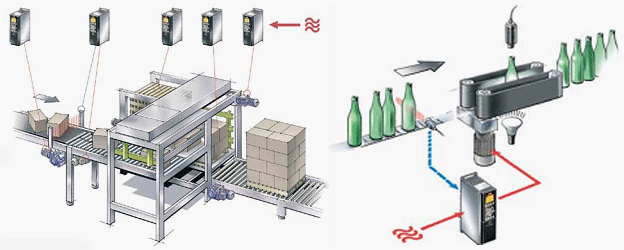Reasons for using variable speed drives
There are many and diverse reasons for using variable speed drives. Some applications, such as paper making machines, cannot run without them while others, such as centrifugal pumps, can benefit from energy savings.
In general, variable speed drives are used to:
- Latch the speed of a drive to the process requirements
- Latch the torque of a drive to the process requirements
- Save energy and improve efficiency
The needs for speed and torque control are usually fairly obvious.
Modern electrical VSDs can be used to accurately maintain the speed of a driven machine to within ±0.1%, independent of load, compared to the speed regulation possible with a conventional fixed speed squirrel cage induction motor, where the speed can vary by as much as 3% from no load to full load.
The benefits of energy savings are not always fully appreciated by many users. These savings are particularly apparent with centrifugal pumps and fans, where load torque increases as the square of the speed and power consumption as the cube of the speed.
An everyday example, which illustrates the benefits of variable speed control, is the motorcar. lt has become such an integral part of our lives that we seldom think about the technology that it represents or that it is simply a variable speed platform. lt is used here to illustrate how variable speed drives are used to improve the speed, torque and energy performance of a machine. It is intuitively obvious that the speed of a motorcar must continuously be controlled by the driver (the operator) to match the trafiic conditions on the road (the process).
In a city, it is necessary to obey speed limits, avoid collisions and to start, accelerate, decelerate and stop when required.
On the open road, the main objective is to get to a destination safely in the shortest time without exceeding the speed limit.
The two main controls that are used to control the speed are the accelerator, which controls the driving torque, and the brake, which adjusts the load torque.
Another important issue for most drivers is the cost of fuel or the cost of energy consumption. The speed is controlled via the accelerator that controls the fuel input to the engine.
By adjusting the accelerator position, the energy consumption is kept to a minimum and is matched to the speed and load conditions. Imagine the high fuel consumption of a vehicle using a fixed accelerator setting and controlling the speed by means of the brake position.
Click here to access the full article

I liked the way you put together everything, there is certainly no need to go any further to look for any additional information. You mentioned each and everything that too with much of ease about Rotar Universal Joints.
ReplyDelete